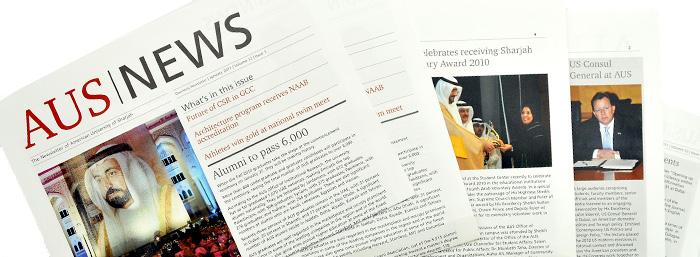- About
- Admissions
- Study at AUS
- Prospective Students
- Bachelor's Degrees
- Master's Degrees
- Doctoral Degrees
- Admission Publications
- International Students
- Contact Admissions
- Grants and Scholarships
- Sponsorship Liaison Services
- Testing Center
- New Undergraduate Student Guide
- Undergraduate Orientation
- New Graduate Student Guide
- Graduate Orientation
- File Completion
- Payment Guide
- Students with Disabilities
- Executive and Continuing Education
- Academics
- Life at AUS
- Research
- Publications
- Contact Us
- Apply Now
- .

AUS research team makes a breakthrough in energy harvesting technology
A research team at American University of Sharjah (AUS) has made an important breakthrough in energy harvesting technology that can benefit many sectors, from bio-medicine to construction. The device works by harnessing electromagnetic radiation from different sources and then reusing it to energize low-power circuits.
Potential uses of the technology include being placed in a medical chip that measures blood sugar levels in diabetes patients; powering wireless sensors on bridges, roads and buildings to monitor structural safety factors; or improving the battery life of mobile phones.
Team members include Dr. Lutfi Albasha, Associate Professor in Electrical Engineering; Dr. Nasser Qaddoumi, Professor and Interim Head of the Department of Electrical Engineering; a full-time research associate and six undergraduate students including three UAE nationals.
"One of the main obstacles present when it came to energy harvesting technology was low efficiency. Despite many innovations in the field, one common problem, in most cases, was that the harvester itself utilized most of the collected energy," Dr. Albasha commented.
Typically, harvesters would provide 5 percent efficiency. However, the AUS team was able to minimize its harvester's energy consumption and to raise efficiency to more than 80 percent. Launched in 2011, the project is set to have its final testing soon.
Sponsored by Semiconductor Research Corporation (SRC) and Mubadala Technologies Company, the AUS team taped-out a chip using Global Foundries 65 nanometer advanced analog CMOS process. The chip comprises dedicated harvester circuits with very high conversion efficiencies.
In addition, the team was also equally successful in designing a novel wide-band antenna for the same system. "The antenna, reported to be the smallest and best-in-class, is very small and enjoys a wide frequency bandwidth. Tests have shown that this flat antenna can pick up signals from mobile phones, TV signals and even Wi-Fi and toll systems at 5GHz," said Dr. Qaddoumi.
"I feel very privileged to be working on this important project and to have been able to contribute to the creation of this unique device. I am very excited about the different innovations and applications our device will be used for in the future. AUS has provided me with many unique opportunities-ones that I would not have had a chance to be part of elsewhere," Khalid Ibrahim, a UAE national student, said.
The energy harvesting research team at AUS has been one of the pioneers in this field. They have participated in numerous international conferences and have had their research published in reputable global journals.

